how to make homemade herbal tea
Learning how to make herbal tea "from scratch" opens up a world of possibilities!
Hot teas, iced teas, herbal tea concentrates ... I'll show you how to make them from your own, homegrown herbs.
There's a ton of information on this page. Read it all at your leisure. Or use these links to jump straight to the topic of your choice ...
What's On This Page?
* Note: Feel free to use fresh or dried herbs - whichever you have on hand. The only difference is the amount of herbs you'll use.
The "rule of thumb" is: 3 units (teaspoons, tablespoons, cups, ounces, etc.) of fresh herbs = 1 unit of dried herbs.
When substituting one for the other, just remember: 3 fresh = 1 dried.
how to make hot herbal tea
What You'll Need:
- Herbs - fresh or dried
- Clean, cold water
- A kettle for heating water
- Tea pot or cup, tea ball, infuser and/or strainer
 Ready to Make Rose Petal Tea
Ready to Make Rose Petal Tea
herbs
Fresh is best! Nothing beats the bright, natural flavor of straight-from-the-garden herbs.
 Herbal Teas Taste As Nice As Their Ingredients Look!
Herbal Teas Taste As Nice As Their Ingredients Look!
Dried herbs make delectable teas, too! As long as your herbs were harvested at the peak of their freshness and properly dried and stored, their flavor will come through beautifully in your cup!
water
I'm often asked, "What's the best water for making herbal tea? Should I use bottled spring water, or is normal tap water okay?"
Tap water is fine, as long as it's clean, fresh, and has no unusual taste or odor. If your water tastes or smells funky, your tea will, too.
How does your tap water measure up? Here's an easy way to tell ...
The "Swirl, Sniff & Sip" Test
Fill a squeaky-clean glass container halfway with tap water. Cover the container, and gently swirl the water around for about 10 seconds. Remove the cover, then sniff and sip.
No odd scent or flavor? Great!
If you detect anything that's even the tiniest bit "off" about your water, consider filtering it.
* FYI: Here's the filter pitcher I chose for our vacation cottage. It does a great job removing the chlorine-y smell and aftertaste from our tap water.
brewing equipment
If you're a loose-leaf tea lover, you likely have all the essential tea-brewing tools in your cabinet already.
So get 'em out and get 'em ready!
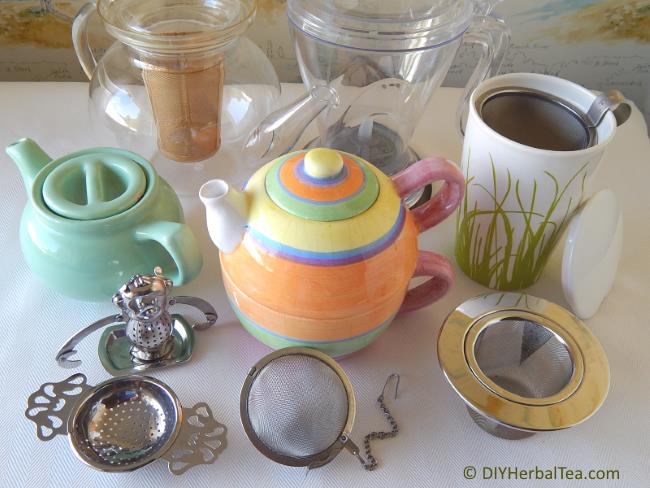 A Few Faves In My "Tea Tool" Collection
A Few Faves In My "Tea Tool" Collection
Need some new tea-making tools? This all-in-one set has everything you'll need to make homemade herbal tea ... cups included!
Okay, enough preliminaries. Let's make some herbal tea!!!
 Beach Rose Petal Tea ... Coming Up!
Beach Rose Petal Tea ... Coming Up!
* URGENT SAFETY REMINDER *
NEVER make tea with rose petals - or any herb - that's been exposed to pesticides or other toxic substances!
It's impossible to rinse away a pesticide/toxin that's been absorbed into a plant's roots, stem, leaves and flowers.
If you're not 100% certain your tea ingredients are, and have always been, completely pesticide and toxin-free, DO NOT use them!!!
1. heat your tea water
How hot? That's a topic of heated (pun intended!) debate among the experts. Some say to bring your tea water to a full boil. Others say to heat it almost to a full boil. I say, let your own taste buds be the judge.
Personally, I'm in the "almost boiling" camp. That's the stage when large bubbles begin to form in the water, and you see the first little "poof" of steam.
It looks like this ...
*TIP: If you do let your water come to a full boil, be sure not to let it go too long at that stage. A minute, at most.
All those bursting bubbles are oxygen escaping from the water. Lose too much oxygen, and your tea will taste "flat". So keep an eye on that kettle!
2. add herbs to your teapot
Before you put fresh herbs into your infuser or into your teapot, rub them gently between your fingers for a few seconds. That helps release their natural oils - the good stuff that gives herbs their scent, flavor and health benefits.
If you're using dried herbs, just break large leaves into small pieces. Don't totally crush them, or you'll end up with a powdery tea.
Flower blossoms and petals can be left whole.
 These Rose Petals Smell Amazing ~ As Will My Tea!
These Rose Petals Smell Amazing ~ As Will My Tea!
Helpful Hint: When you're using a tea ball or infuser, take care not to over-fill it with herbs. About 3/4 full is good. That allows enough room for the water to flow through and extract all that yummy flavor from your herbs.
Put your loose herbs or infuser into the pot. Then pour in your heated water, cover the pot, and ...

3. steep your tea
How long should you steep herbal tea?
Each herb "does its own thing", on its own time schedule. So, as with many things in the DIY herbal tea world, there's no one-size-fits-all answer.
I've found that 5-7 minutes of steeping time is good for most herbs. But there are exceptions.
For example, lavender flower tea tends to become bitter after 3-4 minutes of steeping. And chamomile tea takes upwards of 10 minutes to reach perfection.
That's why I recommend starting with 3-5 minutes of steeping time. Then take a sip every minute or two, taste testing until your tea is just the way you like it.
Tip: When properly brewed, most herbal teas are very light in color. Some have barely any color at all. So don't rely on the color of your tea to determine its strength. Taste, taste, taste!
 Deliciously Fragrant Rose Petal Tea
Deliciously Fragrant Rose Petal Teahow to make herb iceD tea
You're hot. You're tired. You're craving a nice, refreshing glass of iced tea. So what do you do? (No, making a Starbucks run isn't the answer!)
Chill out with your favorite herbal tea - on ice!

Here are three different ways to make herbal iced tea:
hot-brewing iced tea
Making hot-brewed iced tea is as simple as can be!
What You'll Need:
- A pot of freshly made hot tea
- Lots of ice
Instructions:
- Make a large pot of your favorite herbal tea.
- Fill a pitcher with ice,
and pour your tea over the ice.
Viola! In 10 minutes or less, you're sipping your favorite iced herbal tea.
 Lemon Verbena Tea on Ice. Ahhhhhh!!!
Lemon Verbena Tea on Ice. Ahhhhhh!!!
Simple, right? Yes, but. There's a downside to this method.
When hot tea meets cold ice, the ice melts - leaving you with watered-down iced tea. :-(
What's the solution? Use more herbs!
 Stuff That Pitcher Full of Herbs!
Stuff That Pitcher Full of Herbs!
Brew your tea with double the amount of herbs you normally use. When poured over ice, your extra-strong hot tea will become perfect-strength iced tea. :-)
As an alternative: brew your tea normally, then put it in the fridge to chill. In an hour or so, your tea will be fully cooled and ready to drink - without melting your ice.
Helpful Hint: Use left-over teas to make ice cubes.
When the cubes are completely frozen, put them in a zip-loc bag and store them in the freezer. (Be sure to label the bag so you'll know what flavor ice cubes it contains!)
The next time you make iced tea, use your herbal "tea cubes" to chill your drink without diluting it.
how to make herbal sun tea
In the summers of my youth, sun tea was the "it" thing. Nearly every mom and grandmom in our neighborhood had a glass jar filled with water and teabags, brewing in the afternoon sun.
 Old-Fashioned Sun Tea With an Herbal Twist:
Old-Fashioned Sun Tea With an Herbal Twist:Stalks of Homegrown Lemongrass Added to the Mix!
Now that we're growing our own tea ingredients, we can really up the game with a multitude of new sun tea flavors!
What You'll Need:
- A scrupulously clean container. A Mason jar or a clear glass pitcher with lid works perfectly.
- Fresh or dried herbs.
- Clean, cold water.
Instructions:
- Fill your container about 3/4 of the way with fresh herbs, or 1/4 of the way with dried herbs.
- Add enough cold water to nearly fill the container, then put on the lid.
- Set the container in a spot where it'll get direct sunlight for the next 3-4 hours.
 Lemon Balm Sun Tea Brewing On The Backyard Deck
Lemon Balm Sun Tea Brewing On The Backyard Deck
*Important: Leaving your tea in the sun longer than 4 hours invites bacteria growth. If you need additional steeping time, bring the container indoors and stick it in the fridge. Your tea will continue to brew there.
After removing all herbs from the container, store any leftover tea in the fridge. As long it's kept cold, your sun tea will stay fresh and tasty for 24 - 48 hours.
how to make herbal refrigerator tea ("fridge tea")
Herbal fridge tea is made the same way as herbal sun tea, except ...
Instead of using the sun to steep your tea, your refrigerator does the work.
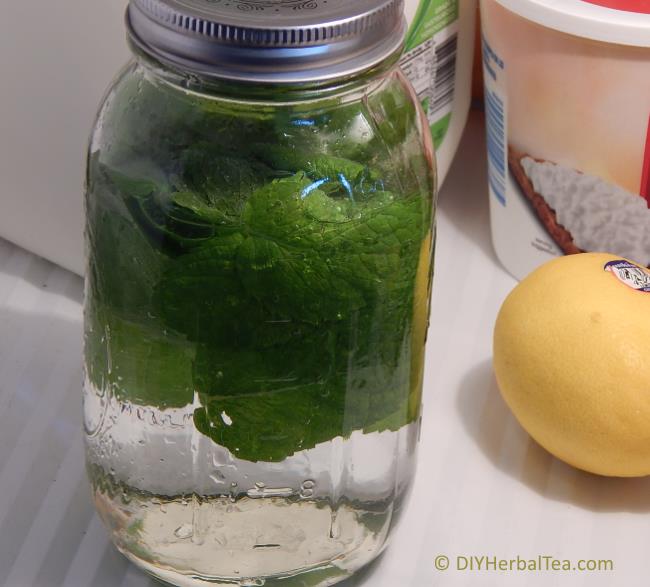 Fridge Tea's Brewin'!
Fridge Tea's Brewin'!
Put your water and herbs in the container before you go to bed, and set
the container in your refrigerator. When morning comes, you'll have
icy-cold herbal fridge tea!
how to make custom herbal tea blends
When I first began learning how to custom-blend herbal teas, I found the same advice in every source I read:
"Combine a few leaves of one herb with a few leaves of another.
Steep, and taste."
That works. But ...
When
you do it that way, you're brewing a new cup of tea each time. If you
love the result, great! But what if you don't ? Down the drain it goes. You've just
wasted precious time and herbs. :-(
the easy way to blend herbal teas
After one too many down-the-drain experiments, I found a much better way. Simply put: Brew first, then blend.
What You'll Need:
- Fresh herbs - multiple varieties
- Near-boiling water
- 12-ounce (355 ml) Mason jars with lids - one jar for each variety of herb
- Tea cup
Instructions:
Gather up a selection of herbs to experiment with.
Using just 5 different varieties of herbs, you'll have 120 possible combinations to taste test. (Remember that "factorial" stuff from junior high math class???)
 Spearmint, Chamomile, Lemon Verbena, Bee Balm Flowers & Stevia
Spearmint, Chamomile, Lemon Verbena, Bee Balm Flowers & Stevia
Put a handful of each herb into its own Mason jar.
Add almost-boiling water, and cover the jars.
Let each jar steep for 5-7 minutes.
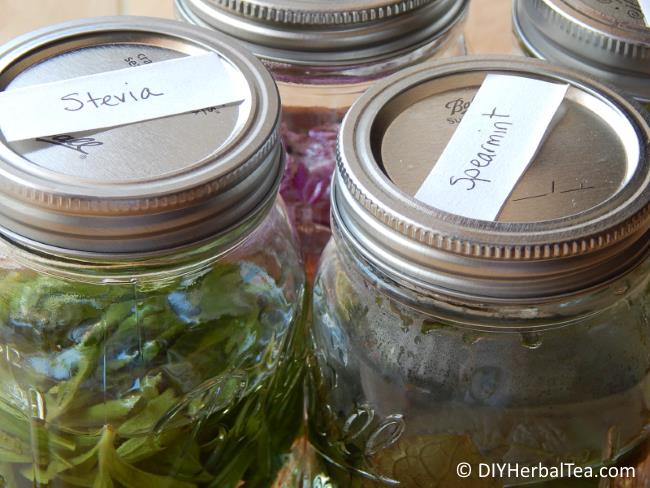 Steeping ...
Steeping ...
When each tea is steeped to perfection, remove the herbs from the jars. And let the experimenting began!
 All Brewed Up & Ready to Go!
All Brewed Up & Ready to Go!
Start with a two-herb blend. Choose any two of your just-brewed teas.
Pour a bit of one tea into your cup, then add some of the other. Swirl the blend around in your cup. Then taste test.
What do you think? Is it delish as it is? Or might it be better with more of one flavor than the other? Experiment until you know for sure.
On the other hand, maybe your taste buds declared that flavor combination to be an epic fail. It's okay! Epic fails happen. Down the drain they go!
Once you've experimented with two-herb blends, move on to three- and four-herb combos.
Play with your teas! You never know what yummy blend you'll discover next!

more custom blending tips
- Label Your Jars.
Once they're brewed, many herbal teas look alike. Rather than resorting to the sniff test to figure out which tea is in which jar, keep it simple. Label your jars before you begin. - Keep a Notebook.
As you're testing different combinations, keep track of what you're doing. When you find a blend you love, note which herbs you used and in what proportion. (Examples: 2 parts chamomile and 1 part stevia; or equal parts spearmint and lemon verbena )
Also note the combinations you've tried and didn't care for. That way, you can easily repeat your successes - and avoid making the same down-the-drain mistakes twice. - Have a Sweetener Handy. A little shot of sweetness sometimes turns a "so-so" mixture into a "Wow!" herbal tea blend. That's why I always have some freshly brewed stevia liquid on hand when I'm experimenting. All-natural sweetness with zero-calories. Love it!
making & Using herbal tea concentrates
What's a "concentrate"? It's a super-duper-strong herbal tea that you brew now and use later to make normal-strength tea.
Having a pool party and need iced tea for 20 people? Make a concentrate!
Want enough home-made tea to hold you through a full day at work? Take a concentrate!
how to make your concentrates
What You'll Need:
- A medium-size, non-reactive cooking pot
- 2 cups of cold water
- 3 cups of fresh herbs, or 1 cup of dried herbs
 Prepping to Make Chocolate Mint Tea Concentrate
Prepping to Make Chocolate Mint Tea Concentrate
Instructions:
- In cooking pot, heat water to a full boil.
- When water boils, remove from heat and immediately add herbs to the pot.
- Stir briefly to make sure all herbs are submerged. Then cover the pan.
- Let the water/herb mixture sit and steep for 5-7 minutes.
- Strain the liquid ("concentrate") into a glass jar or pitcher, and cover tightly.
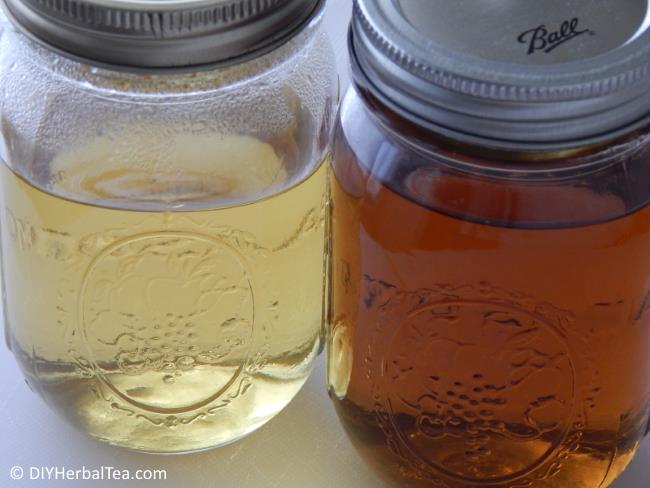 Tea Concentrates Made With Fresh (left) and Dried (right) Herbs
Tea Concentrates Made With Fresh (left) and Dried (right) Herbshow to use your concentrates
When you're ready to serve your tea, mix concentrate with boiling water (for hot tea) or cold water (for iced tea) , to taste.
Note: 2 cups of concentrate yields approximately 1 gallon of tea.
 Chocolate Mint Ice Tea from Homemade Concentrate ~ Yum!
Chocolate Mint Ice Tea from Homemade Concentrate ~ Yum!
handy items for making herbal tea ...

- Home ›
- Making Herbal Tea
If you enjoyed this article and found it helpful, please click the "Like" button to let me know. Thanks!
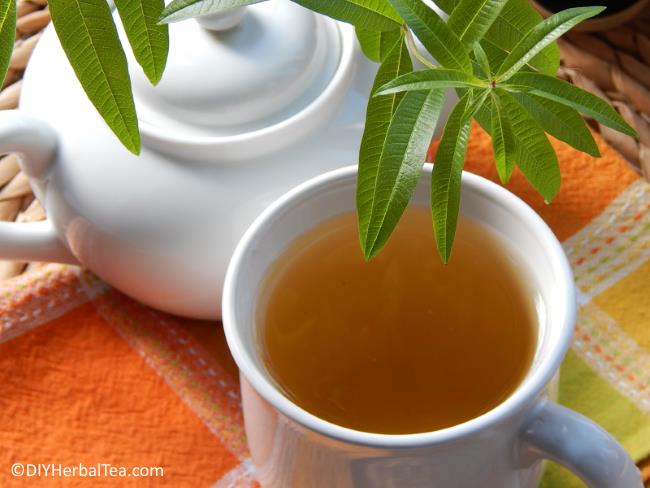
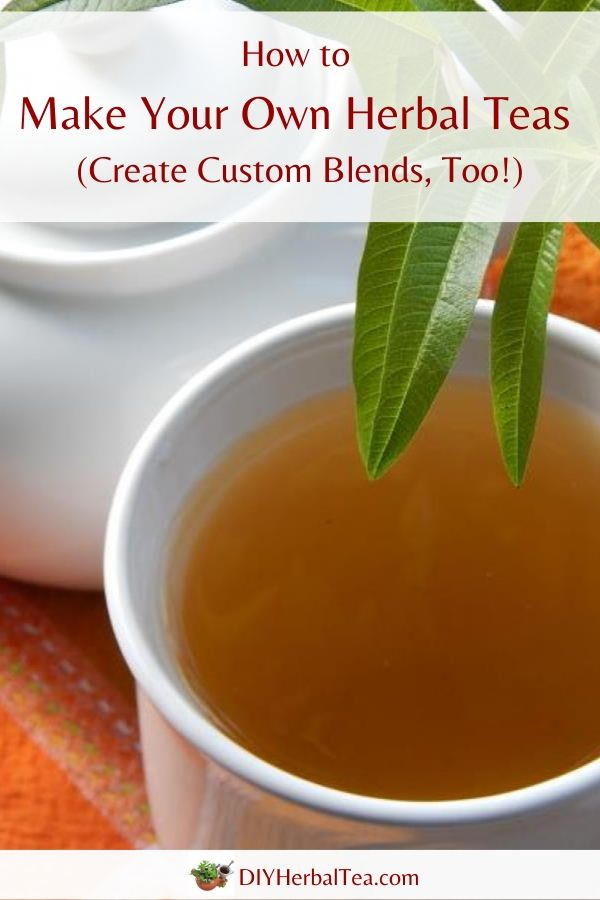
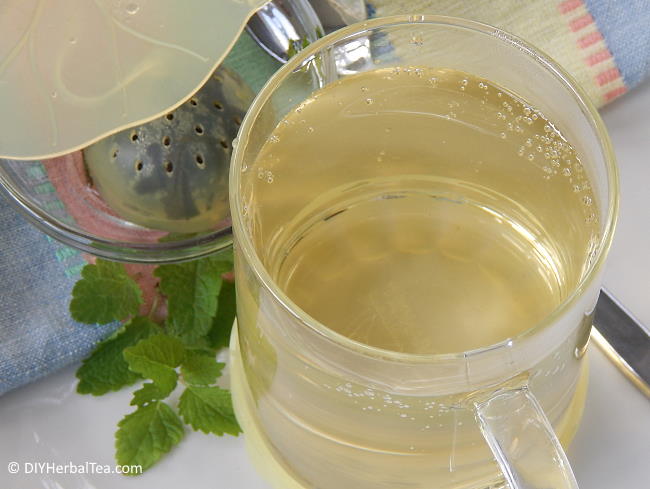
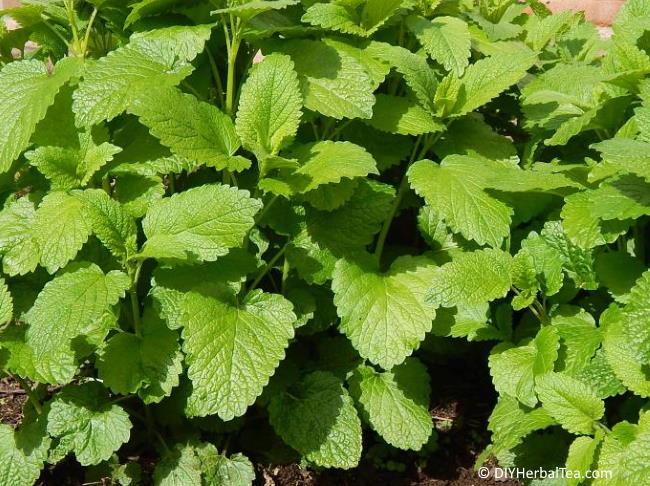
New! Comments
Feel free to leave me a comment in the box below!